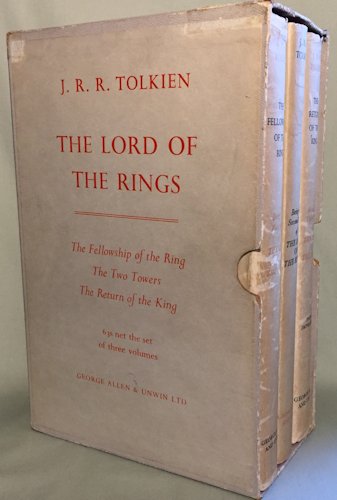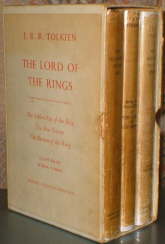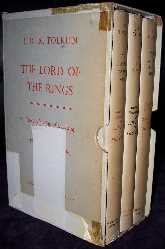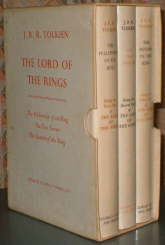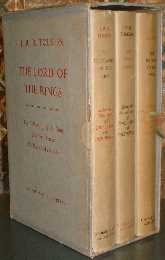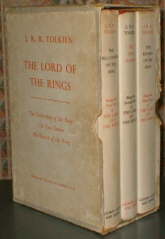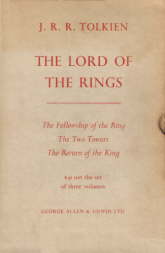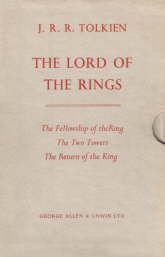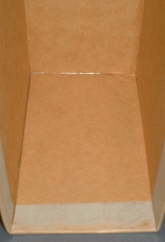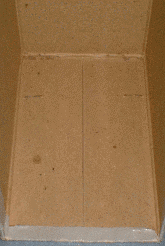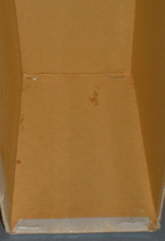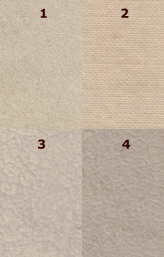Links to Articles
Publishing The Lord of the Rings
V The First Impression of RotK
VI The First Boxed Edition
VII The Readers Union Edition
VIII The First Deluxe Edition
IX Printing and Binding LotR
XIV LotR: A Bibliography
XV LotR: A Bibliography of Slipcases
The History of Middle-earth series
I A Guide to the Contents
II Prices on Dustwrappers
III Original Retail Prices
IV Print Run Sizes
V The Guild Publishing Editions
VI Shaping of Middle-earth Wrapper
VII Peoples of Middle-earth Pulped?
Other Articles
Christopher Tolkien Bibliography
I Think I've Got A Hobbit
Missing Images
Nasty Tricksy Hobbits
Printing and Binding The Hobbit
Songs for the Philologists
The Princess Hobbit
-- Ferguson Dewar
-- Letter from J. R. R. Tolkien
-- Gandalf: Not 'Magician' but 'Wizard'
-- Visions of Gollum
-- Of Smaug and the Jabberwock
-- Magazine Gallery
Tolkien Calendars
Tolkien the Esperantist?
Tolkien's Languages and Alphabets
Unpublished Manuscript Found?
Brief details regarding the First Boxed Edition of The Lord of the Rings can be found in the Slipcased and Boxed Sets section of the main Bibliography. If you own one of these boxed sets and can confirm or contradict the details below please get in touch - Thank you to everybody who has got in touch so far.
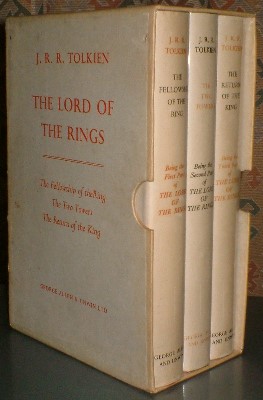 Introduction
Introduction
An Omnibus Edition?
A Simple Solution
The Slipcase - First State
The Slipcase - Second State
The Slipcase - Third State
The Slipcase - Fourth State
The Slipcase - Fifth State
The Slipcase - Sixth State
A New Solution
Construction of the Slipcase
Summary of Production
Image Gallery
References
For more detailed images and additional notes see the image gallery.
Introduction
To date, very little information has been published regarding the First Boxed Edition of The Lord of the Rings. The snippets that are known have been supplied by Wayne G. Hammond:
"Beginning in Autumn 1957, the Allen & Unwin Edition was sold both as separate volumes and as a set. A set of the regular trade edition, 1962 impressions, has been seen in a slipcase covered in light grey imitation leather with a printed label."
J.R.R. Tolkien: A Descriptive Bibliography, p.98
"Michael John Thompson, a bookseller in Vancouver, B.C., has offered for sale an earlier set of The Lord of the Rings in the light grey slipcase; FR, eighth impression (1959); TT, seventh impression (1960); and RK, sixth impression (1960)."
The Tolkien Collector, Issue 12, p.29
|
The following article attempts to trace the development of the set, and to highlight details that will allow a collector to determine if the set of books is original to the slipcase, or if they are later replacements. It is not always possible to be 100% sure which impression numbers were used for a particular batch of boxed sets, so the details given below and collected in the Summary of Production should be treated with a degree of caution.
The following conventions are used below: FR = The Fellowship of the Ring, TT = The Two Towers, RK = The Return of the King. In addition, the terms "boxed sets" and "slipcased sets", and "boxes" and "slipcases", should be taken as equivalents.
An Omnibus Edition?
The publication of The Lord of the Rings was delayed for several years by Tolkien's desire to see it published as a single volume, and to follow it up with The Silmarillion. After failing to secure an agreement to publish both books with either Allen & Unwin or Collins, he eventually relented and accepted an offer from Allen & Unwin to publish The Lord of the Rings in three volumes, and to consider the publication of The Silmarillion at a later date. Very soon after publication it became obvious that The Lord of the Rings was popular with the book buying public, and as early as 1955 A&U were considering the possibility of issuing an omnibus edition. A&U looked into the possibility again in January 1959, this time going as far as obtaining estimates from the printers, Jarrold & Sons, but the matter was not taken forward, perhaps for reasons of cost.
There the matter rested, until in 1965 negotiations commenced with Pan Books for the publication of a paperback edition. These discussions carried on until 1966 but were brought to a halt when Tolkien withheld his consent. The three volumes were eventually unified (minus most of the Appendices) in 1968 with the publication of Allen & Unwin's single volume Paperback Edition, and the following year the complete text finally appeared in one volume in the Deluxe India Paper Edition.
A Simple Solution
As noted above the books proved to be popular, so Allen & Unwin thought that there may be a market for a collected edition of the three volumes. Some readers had already chosen to construct their own by binding the three books together - in January 1956 a "leading bookseller" requested unbound sheets to make one for his own library. In July 1957 Allen & Unwin decided that they would introduce a Boxed Edition of The Lord of the Rings. This would consist of the standard trade editions of The Fellowship of the Ring, The Two Towers and The Return of the King in a simple grey paper covered card slipcase with a label pasted onto the side. On 30 July 1957 Rayner Unwin informed Tolkien that A&U would be issuing the set that Autumn.
The Slipcase - First State
C. Davidson & Sons of Erith in Kent made the first batch of 500 slipcases in August 1957. The paste-on labels for these were printed by Jarrold & Sons of Norwich, the printers of most impressions of The Lord of the Rings, on the same Caldecott Silver Grey paper used for the dustwrappers.
The empty boxes were delivered to Jarrolds in mid-September. At this time The Fellowship of the Ring was being printed and bound by Purnell & Sons of Paulton in Somerset rather than Jarrold & Sons. At the end of September they sent 500 copies of the 6th Impression 1956 to Jarrolds - 400 from the 2nd binding of 1500 copies and 100 from 3rd and final binding of 500 copies. [Note that the 6th Impression December 1956 misidentifies itself as the 5th Impression December 1956.] Jarrolds had just completed the binding of the first 2,500 copies of the 5th Impression 1957 of The Two Towers, and were in the process of binding the last 1,500 copies of the 3rd Impression 1957 of The Return of the King. Jarrolds boxed up 500 sets at the beginning of October and dispatched the first batch of 50 sets to Allen & Unwin on the 10 October 1957 . The first Lord of the Rings boxed set was born.
This slipcase was made using a light weight board - a single piece formed the side and rear panels, and smaller pieces were used for the top and base. [See below for further details] It was covered in a pale grey paper, with a leather-like texture. The label can be distinguished from the third and later states by the presence of the price printed on the paste-on label - 63s net the set of three volumes.
The Slipcase - Second State
On 18 September 1958, Ronald Eames, of the A&U Production Department, contacted Jarrold & Sons to enquire as to whether they could supply slipcases for the boxed edition - either made themselves or by a local company. Mr. Eames noted that A&U were unhappy with the previous slipcases and had received many complaints about them. He thought that the boards needed to be heavier and more securely held together, and that a darker grey paper should be used to cover the box.
Correspondence regarding the slipcases continued (with the strength of the slipcase being raised constantly) and an estimate and specimen were produced. On 24 October Mr. Eames responded regarding the specimen: It was not a great improvement on the slipcase made by Davidsons and had been damaged in the post; it seemed to him that the boards should be twice as thick as those used. A new specimen was produced, and on 5 November it was approved and an order placed for 500 boxes.
This slipcase was made using a medium weight board - a single piece formed the side and rear panels, and smaller pieces were used for the top and base. [See below for further details] It was covered in a pale grey paper, with a leather- like texture. The label was un-changed from the first state.
As with the first state of the slipcase, the second state can be distinguished from later states by the presence of the price printed on the paste-on label - 63s net the set of three volumes.
On 5 November Purnell & Sons sent 150 copies of the 7th Impression 1957 of FR. Jarrolds boxed these up with copies of the 5th Impression 1957 of TT and the 4th Impression 1958 of RK. In both November 1958 and February 1959 Ronald Eames commented to Purnells that copies of The Fellowship of the Ring received in recent deliveries did not not match the volumes from Jarrolds because they did not have the usual red top to the page edges and were trimmed to Demy 8vo size rather than the normal Medium 8vo [a difference in height of 6mm or 1/4 inch]. However, the copies in the second state boxed sets seen are the correct size and have the red top edge, so the Demy 8vo copies may not have been included in any boxed sets.
On 19 February 1959, Allen & Unwin asked Purnells to send 250 copies of the 8th Impression of FR to Jarrolds in Norwich, who boxed these together with copies of the 5th Impression 1957 of TT and the 4th Impression 1958 of RK.
Purnells sent yet another 250 copies of FR to Norwich on the 7 May. There appears to have been a delay in boxing however, possibly due to a lack of bound stock of the second volume. The final 100 empty second state boxes were filled in August, with copies of the 8th Impression 1959 of FR, the 6th Impression 1959 of TT and the 4th Impression 1958 of RK.
The Slipcase - Third State
On 11 June 1959 Ronald Eames (now Production Manager, since the sudden death of Walter Beard at the end of 1958) informed Jarrolds that A&U required a total of 500 slipcases, including the 100 remaining from the November 1958 batch. The design for the extra 400 slipcases would not be changed, but the label needed to be modified by the removal of the price.
As noted above, there appears to have been a delay in the completion of these 500 boxed sets, probably because of a lack of bound copies of The Two Towers. On 25 August Mr. Eames informed Jarrolds that he had sent a binding order for TT, and that while the 500 boxed sets were still required, it would be in order to complete only 250 at that time. The 100 second state slipcases and 150 of the third state slipcases were filled with copies of the 8th Impression 1959 of FR, the 6th Impression 1959 of TT and the 4th Impression 1958 of RK.
When the other 250 boxes were filled in unclear, but they must have been completed by 10 November, when an internal memo gives the stock figure as 350 sets. They were probably filled with copies of the 8th Impression 1959 of FR, the 6th Impression 1959 of TT and the 5th Impression 1959 of RK.
The Slipcase - Fourth State
Problems with the slipcases flared up again in November 1959: Mr. Eames informed Jarrolds that they were being damaged in transit between Norwich and the A&U warehouse. On 18 November he suggested that the slipcase be made with a millboard and covered with something more robust such as a material called Elephant Hide. [Millboard is a good quality board often used for the covers of books, usually made from rope, fibre refuse or wood pulp. In this case, Elephant Hide is likely to be a trade name for a hard-wearing type of bookbinding fabric] The following week, while enquiring about the cost of inserting the books into the boxes, Mr. Eames suggested the use of linson instead of paper to cover the slipcases. [Linson is a trade name for a bookbinding fabric, a tough fibrous paper that often has a textured surface similar to linen]
A linson-covered specimen appears to have been received by A&U at the start of December. Ronald Eames comments that the new slipcase has arrived undamaged, but wonders if this is because it did not contain any books. Accordingly, he returned it to Jarrolds with books inserted to see if it would complete the journey intact. Two weeks later, on 17 December, another linson-covered specimen was received from Jarrolds. This was damaged on one corner, and Mr. Eames commented that whereas the earlier slipcases would have fallen apart, the new design stood up to this treatment quite well. He was less happy about the join in the card halfway down each side of the slipcase, but accepted that this was to avoid joining at the corners - the ideal slipcase would be one without any joins. [Previous slipcases all had joins along the top and bottom edges]
A letter dated 21 December asked for the slipcases to be covered in Glindura rather than linson. [Glindura is a trade name for a non-woven bookbinding fabric. Ronald Eames comments suggest that it was cheaper than linson] An order was placed for 250 slipcases, but it is uncertain whether they were filled with books at this time. If they were filled, then copies of the 8th Impression 1959 of FR, the 6th Impression 1959 of TT and the 5th Impression 1959 of RK were used. The only example of the fourth state slipcase seen appears to be covered with linson not Glindura - it has the same embossed texture as the material used for the 1964 Deluxe Edition slipcase, which is definitely linson. Why Glindura was not used is not known.
Only one fourth state slipcase has been seen and this does not have the joins halfway down each side as noted above. It has the same construction as the earlier states of the slipcase - a single piece of cardboard forming the side and rear panels with smaller pieces used for the top and base - therefore it has the joins along the top and bottom edges that Mr. Eames was so eager to avoid.
While it may be unclear whether any sets were boxed at the end of 1959, what can be said with more certainty is that one batch of this state of the slipcase was filled with books in 1960. Purnells sent 500 copies of the 8th Impression 1959 of The Fellowship of the Ring to Jarrolds in April and 310 copies of the 9th Impression 1960 in May.
[Note that the 9th Impression 1960 misidentifies itself as the 8th Impression 1960 on the verso of the title page, but comes in a dustwrapper marked 'Ninth Impression']
In both instances they were boxed along with copies of the 6th Impression 1959 of TT and the 5th Impression 1959 of RK. The final batch seems to have been made up in November using 1960 impressions of all three volumes.
[Correspondence regarding the Boxed Edition is rather patchy for the period 1960-61, so it is possible that more boxed sets were put together in this period than is indicated above]
The quote from Issue 12 of The Tolkien Collector magazine given at the start of this article throws up a problem. The 8th Impression 1959 of FR should not be found in slipcases with the 7th Impression 1960 of TT and the 6th Impression 1960 of RK - supplies would have been exhausted several months before the slipcases were filled. It may be that the bookseller's description noted an 8th Impression and Wayne Hammond has inserted the year 1959, overlooking the fact that the 9th Impression incorrectly identifies itself as the 8th Impression 1960. [Postscript: This can now be confirmed - see this post at Usenet]
The Slipcase - Fifth State
On 9 December 1960 Mr. Eames again wrote to Jarrolds to comment on the condition in which the slipcases were being received. Following this there appears to have been no correspondence between A&U and Jarrolds regarding the Boxed Edition for nearly six months. Unfortunately this gap ties in with the lifespan of the fifth state of the slipcase.
Three examples of the fifth state of the slipcase have been seen and, while there are minor differences between them, they all have the same basic design. Although this new design reverts back from linson to the textured paper covering, it represents a step forward in some respects because it eliminated the most vulnerable joins on the top and bottom edges of the box. This was achieved by using a single piece of board, folded and then stapled at each corner of the top and base panels. [See below for further details]
The earliest example of the fifth state slipcase seen includes a 9th Impression copy of FR, a 7th Impression of TT and a 6th Impression of RK - all from 1960 - and was probably boxed up in December 1960 or January 1961. Further sets have been seen that include 10th/7th/6th and 10th/7th/7th Impressions of the three volumes. These date from approximately February 1961 and April 1961 respectively. The number of sets made in each of these batches is unknown, but was probably no more than a few hundred copies.
The Slipcase - Sixth State
There were more problems with the slipcase in May 1961, when Ronald Eames reported that they were arriving at the A&U warehouse in poor condition. After some discussion Jarrolds supplied a new specimen. On 19 June Mr. Eames responded to say that it seemed to be more satisfactory, but was a little sceptical as to whether it would prove to be so in practice. He also added that comments had been received to the effect that recent slipcases were perhaps 1/8 inch too large. This design, whilst not perfect by any means, was used for the next three years, and in this period the number of boxed sets produced increased markedly.
Like the fifth state, this new slipcase design eliminated the most vulnerable joins on the top and bottom edges of the box. This was achieved by constructing two half slipcases, each having the top, rear and base panels and one side panel. These were overlapped and stapled at each corner of the top and base panels. [See below for further details]
As noted above, the correspondence regarding the Boxed Edition for 1960-61 is very patchy so it is possible that more fourth, fifth and sixth state slipcased sets were produced than is indicated here. This may be because the Boxed Edition had become a standard feature of the A&U list so did not warrant the correspondence and explanation that the early issued sets received - A&U submitted orders for printing, binding and boxing, etc on pre-printed forms, and these are not preserved in the correspondence archive. The production details for 1962-64 are documented in much greater detail, but this is only because of disagreements between A&U and Jarrolds regarding the stock position of the three volumes and the Boxed Edition, and the number and size of deliveries made.
Judging from the correspondence, there were severe problems with the supply of slipcases and boxed sets in the latter part of 1961 and early 1962, and again in 1963. The difficulties appear to have been due not only to a lack of bound stock, but also due to problems with the supply of empty boxes from the subcontractor used by Jarrolds to make the slipcases.
Yet more problems with the slipcases were reported in December 1962 - they were much too large for the books, causing a loose fit, which meant that the box was more susceptible to damage. Mr. Eames asked for future cases to be improved, but there is little evidence that this was achieved - most fifth and sixth state slipcases seen (1961-64) are oversized and allow the books to slide about.
For the period July 1961 through to September 1964 there are eighteen batches of slipcases recorded, totaling over 8,000 sets. The first batch included copies of the 10th Impression 1961 of FR, the 8th Impression 1961 of TT and the 7th Impression 1961 of RK. A variety of impressions were included until, in the final batch of 230 sets, copies of the 13th Impression 1963 of FR, the 10th Impression 1963 of TT and the 10th Impression 1963 of RK were used.
A New Solution
On 23 March 1964, Ronald Eames contacted Jarrolds to inform them that A&U would be dropping the general Boxed Edition, but wished to consider the possibility of producing a Deluxe Edition. Despite the fact that the Boxed Edition was selling well, there were obvious problems with the slipcase that were no doubt attracting a constant stream of complaints and, because no charge was made for the slipcase, the cost came straight out of the profits. Better quality slipcases could be produced, but these came at a cost.
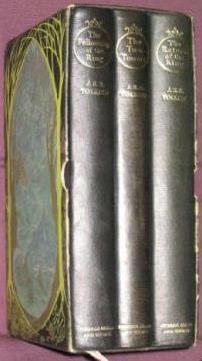 The solution to the problem was to significantly upgrade the quality of the bindings and the slipcase. This new Deluxe Edition would consist of the three volumes bound in buckram with a very stout illustrated slipcase and would command a 'premium' price. The writing was on the wall - the first Lord of the Rings Boxed Edition had had its day.
The solution to the problem was to significantly upgrade the quality of the bindings and the slipcase. This new Deluxe Edition would consist of the three volumes bound in buckram with a very stout illustrated slipcase and would command a 'premium' price. The writing was on the wall - the first Lord of the Rings Boxed Edition had had its day.
The publishing history of the First Deluxe Edition of The Lord of the Rings is discussed in a separate article.
Construction of the Slipcase
The details of the design of the slipcase were modified regularly throughout the life of the First Boxed Edition. Allen & Unwin and Jarrolds were trying to balance the need for a robust slipcase against need to keep costs to a minimum - the boxed sets retailed at the same price as the three volumes on their own. [The cost of making 500 slipcases and insertion of the three volumes was usually £23 - or roughly one shilling per set]
Essentially there were three basic designs utilised for the boxes. The first design was used from 1957 until 1960 (First to Fourth States). This used three pieces of board - a single piece formed the side and rear panels, and smaller pieces were used for the top and base. See the diagram below - when the slipcase is assembled the pairs of letters meet, i.e. AA, A'A', BB, B'B'.
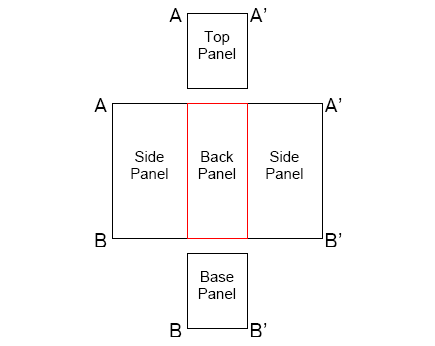 |
These were held together by the covering material - paper or linson. This type of construction is susceptible to splitting along the joins on the top and bottom edges, especially in the paper covered variants. The board used for the first state slipcase appears to have been very thin, in contrast, the board used for the second, third and fourth state boxes was quite substantial (~2mm thick). For the fifth and sixth state slipcases, a relatively thin board was used again (~1mm thick).
The second design was used from around December 1960 until mid-1961 (the Fifth State). This used a single piece of board that was folded to form the slipcase. The overlapped panels and flaps were stapled at each corner of the top and base panels - this leaves a visible join inside the slipcase that runs down the centre of the top and base panels. See the diagram below - when the slipcase is assembled the pairs of letters meet, i.e. AA, A'A', BB, B'B', CC, C'C'.
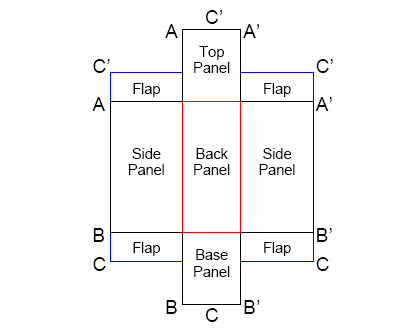 |
The third and final design was introduced in mid-1961 (the Sixth State). This only used two pieces of board. The slipcase was made from two partial slipcases. Each half included the top, rear and base panels and one side panel. These were overlapped and stapled at each corner of the top and base panels. See the diagram below - when the slipcase is assembled the pairs of letters meet, i.e. AA, A'A', BB, B'B'.
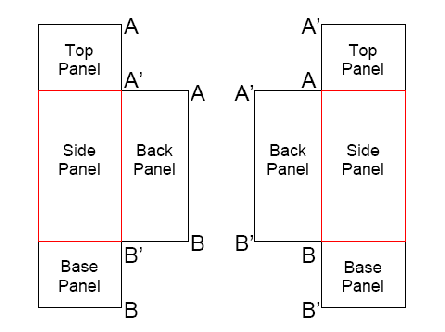 |
The overlapping back panels were held together by the paper covering material. The type of construction used for the Fifth and Sixth States should (in theory) be stronger than the earlier three piece design, but the majority of boxes were made were too large, meaning that the books could move around inside. This, and the thinner board used, allowed the slipcase to twist, making it susceptible to splitting.
Two types of material were used to cover the slipcase. The first was a grey paper with a leather like textured finish. The paper used for the second and third states of the slipcase (and possibly the first as well) had a finish similar to a fine textured leather, while that used for the fifth and sixth states had a much coarser leather-like texture. Both variants of the paper were prone to rubbing, chipping and discolouration. The other type of material used was linson, a very tough fibrous paper, with a surface texture that is reminiscent of linen. This was only used for the fourth state of the slipcase. Its robust nature meant that it was much less susceptible to rubbing, chipping and discolouration. There is no mention in the correspondence as to why the use of linson was abandoned, but it was almost certain down to cost.
Summary of Production
It is not always possible to be 100% sure which impression numbers were used for a particular batch of boxed sets, so the details given below should be treated with a degree of caution.
At times the correspondence between A&U and Jarrolds lacks the detail necessary to be sure of dates and/or quantities. Where dates or figures given below are particularly questionable this is indicated by '??'. [See the notes after the table for further details]
If you own one of these boxed sets and can confirm or contradict any of the details below please get in touch.
|
|||||||||||||||||||||||||||||||||||||||||||||||||||||||||||||||||||||||||||||||||||||||||||||||||||||||||||||||||||||||||||||||||||||||||||||||||||||||||||||||||||||||||||||||||||||||||||||||||||||||||||
* The 6th Impression 1956 of FR misidentifies itself as the 5th Impression December 1956.
** The 9th Impression 1960 of FR misidentifies itself as the 8th Impression 1960.
The Two Towers - 5th Impression 1957 - It is unclear whether the 6th Impression was bound in January or March 1959, so the February 1959 batch of boxed sets could contain 5th or 6th Impressions.
October 1959 - This date could be as early as September, or as late as November.
December 1959 - It is not clear from the correspondence whether or not the 250 slipcases ordered were actually filled at this time, therefore the total quantity made for this state may only be 750.
Fifth State of the slipcase - There is little correspondence relating to the Fifth State of the slipcase, so the dates given above for the 3rd, 4th and 5th batches are based on the dates when bound copies of each impression became available.
1960-1961 - Correspondence is rather patchy for the period 1960-61, so it is possible that more boxed sets were put together in this period than is indicated above, therefore the total quantities reported for the fourth, fifth and sixth states should be treated with some caution.
1963-1964 - The 1963 Impressions were introduced into the Boxed Edition gradually, FR first in January 1964, then TT and finally RK. It is quite possible that the introduction actually occurred within one batch of 500 sets, rather than the three show above.
References
The Letters of J.R.R. Tolkien
Edited by Humphrey Carpenter with the assistance of Christopher Tolkien. 1981.
George Allen and Unwin, London. ISBN 0048260053.
J.R.R. Tolkien: A Descriptive Bibliography
Wayne G. Hammond with the assistance of Douglas A. Anderson. 1993.
St. Paul's Bibliographies, Winchester. ISBN 1873040113.
Oak Knoll Books, New Castle, Delaware. ISBN 0938768425.
The Tolkien Collector
Edited by Christina Scull. Issue 12, February 1996. Williamstown, MA.
See especially pp.28-29, 'Addenda and Corrigenda to J.R.R. Tolkien: A Descriptive Bibliography' by Wayne G. Hammond.
The Tolkien Collector
Edited by Christina Scull. Issue 20, July 1999. Williamstown, MA.
See especially p.31, footnote 1 to 'Identifying First Edition Printings of the Houghton Mifflin Lord of the Rings - Part I' by Steven M. Frisby.
George Allen & Unwin: A Remembrancer
Rayner Unwin. 1999.
Merlin Unwin Books, Ludlow. ISBN 1873674376.
The J.R.R. Tolkien Companion & Guide: Chronology
Christina Scull and Wayne Hammond. 2006.
HarperCollins, London. ISBN 0261103814 / 9780261103818.
See especially the entries for 30 July 1957 and 15 April 1964.
Glossary of the Book
Geoffrey Ashall Glaister. 1960.
George Allen and Unwin, London.
Allen & Unwin Archive
RUL MS 3282 - AUC 680/5 (Letters to/from Houghton Mifflin 1955)
RUL MS 3282 - AUC 681/12 (Letters to/from Jarrold & Sons 1955)
RUL MS 3282 - AUC 722/8 (Letters to/from Jarrold & Sons 1956)
RUL MS 3282 - AUC 732/9 (Letters to/from Purnell & Sons 1956)
RUL MS 3282 - AUC 753/7 (Letters file DAR-DAZ 1957)
RUL MS 3282 - AUC 763/1 (Letters to/from Jarrold & Sons 1957)
RUL MS 3282 - AUC 773/10 (Letters to/from Purnell & Sons 1957)
RUL MS 3282 - AUC 801/1 (Letters to/from Jarrold & Sons 1958)
RUL MS 3282 - AUC 811/6 (Letters to/from Purnell & Sons 1958)
RUL MS 3282 - AUC 837/6 (Letters to/from Jarrold & Sons 1959)
RUL MS 3282 - AUC 847/8 (Letters to/from Purnell & Sons 1959)
RUL MS 3282 - AUC 874/4 (Letters to/from Jarrold & Sons 1960)
RUL MS 3282 - AUC 884/4 (Letters to/from Purnell & Sons 1960)
RUL MS 3282 - AUC 910/20 (Letters to/from Jarrold & Sons 1961)
RUL MS 3282 - AUC 949/5 (Letters to/from Jarrold & Sons 1962)
RUL MS 3282 - AUC 988/15 (Letters to/from Jarrold & Sons 1963)
RUL MS 3282 - AUC 1013/5 (Letters file BAS-BD 1964)
RUL MS 3282 - AUC 1028/14 (Letters to/from Jarrold & Sons 1964)
RUL MS 3282 - AUC 1071/13 (Letters to/from Jarrold & Sons 1965)
RUL MS 3282 - AUC 1081/13 (Letters to/from Pan Books 1965)
RUL MS 3282 - AUC 1126/14 (Letters to/from Pan Books 1966)
| If you are looking for new, secondhand or out-of-print books then AbeBooks UK may be able to help. |
|
|
| Alternatively, you can search and order through AbeBooks.com. |
|
|
